Martin Edwards's Blog, page 65
December 22, 2021
Let the Right One In - 2008 film review
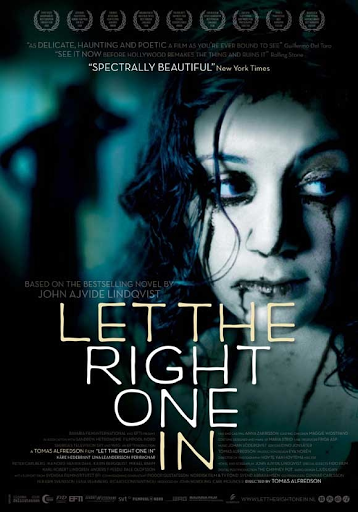
Let the Right One In is a Swedish horror film directed by Tomas Alfredson and based on a popular novel by John Ajvide Lindqvist, who also wrote the screenplay. It is highly rated by the cognoscenti and an American remake, Let Me In, was equally successful. I haven't read the book but I was tempted to watch the Swedish screen version, which is certainly out of the ordinary.
Oskar is a 12 year old boy who lives in a flat in a suburb of Stockholm with his mother, a single parent. He does see his father from time to time, but at school he is bullied by other boys. A girl of the same age, Eli, moves in next door. She's living with an older man, although he doesn't seem to be her father. The early scenes are episodic and at first the story's direction of travel is uncertain. But then the older man kill someone in a wood and harvests his blood. Before we know it, Eli too has killed someone.
Very disconcerting. But Oskar and Eli get to know each other and a strange bond develops between them - to such an extent that this is sometimes described as a 'romantic horror film'. Eli encourages Oskar to stand up for himself, and he takes her advice to heart to such an extent that he severely wounds one of the school bullies. In due course, they decide to take revenge....
This is quite a long film, and there are quiet patches, interspersed with bursts of dramatic action and violence. The overall effect is unsettling, as Alfredson no doubt intended. The cinematography is first-rate, capturing the eerie nature of the landscape, both rural and urban. I don't want to give too much away, but suffice to say that the story offers a new take on a familiar theme. It works well.
December 20, 2021
The Appeal by Janice Hallett - book review
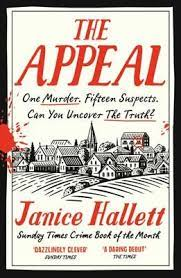
The Appeal is a debut crime novel by Janice Hallett, a screenwriter and playwright with a lifelong love of amateur dramatics that shines through. The book has had enormous success and I must say right away that I really enjoyed reading it. The story kept me gripped throughout and I expect that it will feature strongly in the award nominations in due course. It certainly deserves to do so.
A number of reviews and endorsements have hailed the book's originality. For me, the originality lies in the treatment of the material, since the structure resembles that of two detective novels which appeared in that landmark year 1930. The epistolary form is strongly reminiscent of The Documents in the Case, which I believe is Dorothy L. Sayers' most under-rated novel, the result of a one-off collaboration with Robert Eustace. In addition, there is a 'whowasdunin' element of the kind which seems to have originated with Anthony Berkeley's Murder in the Basement. But Hallett gives these concepts a very effective makeover. The documents in this case are nearly all emails (as in Joseph Knox's True Crime Story) while Hallett cleverly presents three connected mysteries. First, who has been killed? Second, who has been convicted of the murder? Third, who is really guilty?
At the outset, two keen young lawyers are tasked by their boss (Roderick Tanner QC) with looking at a hefty bundle of documents without preconceptions. They find that they are following the activities of The Fairway Players, an am dram group who are about to put on Miller's All My Sons. Those activities are complicated by the fact that Martin Hayward, wealthy chair of the group, has a grand-daughter called Poppy who at the age of 2 is suffering from cancer. An appeal is launched on Poppy's behalf, but the ensuing financial shenanigans raise early questions about the motives of the Hayward family, whose behaviour is not quite what one would expect, to say the least. There are plenty of funny moments, especially in the behaviour of Issy, a nurse and evident fantasist who latches on to Sam Greenwood, a nurse who has recently returned to the UK from Africa. And there are occasional touches of darkness too.
There are numerous plot twists, some of them foreseeable, some of them less so. They vary in effectiveness, but there is one trick (concerning an invented character) that I should have spotted, yet Janice Hallett fooled me completely and splendidly. Jim Noy has reviewed the book with his customary incisiveness at The Invisible Event and I think his assessment is fair and accurate. As Jim says, there is a vast cast of characters, including two men in their 30s called Kel and Kev respectively, and all this can be a bit confusing. However, the voices of the lead characters are pleasingly distinctive. The am dram background seems to me to be extremely well done.
I was much less convinced by the legal element, which clearly didn't interest the author very much (though Femi and Charlotte are entertaining amateur sleuths). There's a lack of coherence and clarity as to whether the lawyers are barristers or solicitors. Tanner is a QC but also appears to be a senior partner in a solicitors' firm. There's a suggestion that Femi and Charlotte are 'articled clerks', aka trainee solicitors, although as Jim indicates, most people will assume they are pupil barristers. So who is actually handling the court case? Most readers won't care about this, and an author can be forgiven for vagueness about details. It's common to find misconceptions about the law and legal life in novels - I can think of at least one terrific bestselling writer who has stumbled into minor errors in recent times - but a book as entertaining as this deserved more editorial work to make the set-up seem more credible. It could have been done easily.
But let me not dwell on legal quibbles. The Sunday Times has described Hallett as 'a modern Agatha Christie', and it's good to see Agatha still regularly name-checked when crime writers are praised. Hallett is a very different writer but her ingenuity is admirable and her sense of humour really appealing. I very much look forward to reading her next book.
December 17, 2021
Forgotten Book - The Second Shot

Anthony Berkeley's The Second Shot is rare if not unique among detective novels for being more renowned for its preface than for the substance of its story. In what is really an extended dedication to his literary agent, the legendary A.D. Peters (whose former wife Berkeley married not long afterwards), he argued that 'the detective story is already in process of developing into the novel with a detective or crime interest, holding its reader less by mathematical than psychological ties.' This opinion was quoted with approval by Julian Symons in Bloody Murder and I agree that Berkeley was spot on.
Symons pointed out that in fact this particular novel did much less to demonstrate the point Berkeley was making than did his first Francis Iles book, Malice Aforethought. Again, I agree. Nevertheless, it's a distinctive effort, a Roger Sheringham mystery narrated by Cyril Pinkerton, although Pinkerton certainly isn't a Watson-character. In fact, he's the prime suspect for the murder of loathsome Eric Scott-Davies.
Berkeley's ideas about crime, punishment, and justice were invariably as interesting and often as controversial as his opinions (and he was never short of opinions) about the crime genre. This novel was, along with Gladys Mitchell's Speedy Death, one of the first Golden Age puzzle to tackle head-on - explicitly, rather than by implication - the notion of the 'altruistic crime', which I explored in The Golden Age of Murder. If you can think of an earlier example, do let me know. Christie, Carr, and others tackled the 'altruistic crime' during the Thirties, but Berkeley led the way.
Apart from Sheringham, the writer Morton Harrogate Bradley, who had appeared in The Poisoned Chocolates Case, pops up in the story, albeit without contributing much. There's also passing mention of Alice Dammers, from the same novel. This novel reflects his habit of fictionalising real life places and people. There's a wonderful map on the endpapers of the crime scene, Minton Deeps, which was based on Berkeley's own Devon home, Linton Hills. I suspect that Paul de Revel and his glamorous wife were based on people in Berkeley's circle (E.M. Delafield and her husband Paul, perhaps?). The same may also be true of Armorel Scott-Davies, who plays a central role in the story.
The main problem with the novel is that, after a sprightly start, the pace drags. Berkeley's prose is never less than readable, but there is endless discussion about who was where and when. There are compensations in the way Berkeley juggles multiple false solutions, while the final revelation of the culprit is highly characteristic of his ironic approach to crime writing: he gives a fresh twist to a narrative technique that had been around for a few years. This novel was published in 1930, a year that in many ways marked a turning point in the genre. Berkeley was one of those who showed the way ahead, and his influence continues to be felt.
December 15, 2021
Introducing The Underground Game by Fei Wu

When I visited Shanghai in 2019 I spent a good deal of time in the company of my host Fei Wu, a Chinese crime writer who shares my great enthusiasm for the genre. At that point, he'd just produced his first interactive mystery novel, The Lost Winner. Now he's produced a follow-up called The Underground Game. I asked him to describe the story:
'On the early morning of Christmas, a metro line disappeared from the monitor of the transportation control centre. It never happened before so the operator was alarmed and reported the situation to his boss. Soon it was proved that the train was hijacked by someone. They also learned from the driver who escaped from the train that a bomb was set up somewhere in it.
In the meantime, the passengers on the subway were being ordered to finish a task before the train, which was on a loop line, returned to its starting place.
The order was given from the broadcasting system of the train and it was very strange.
"You need to find a victim who was killed at the station, otherwise you are in big trouble."
How could the passengers locate a victim they might not know at all?
Why was the train hijacked?
What's the relationship between the victim and the train?
When could the police save the passengers from the moving locked room?
In the box that comes with the story, you will find puzzle pieces. They are the clues left in the compartment by the suspect. The readers should play the role of passengers and try to solve the puzzle.
Again, as my previous book, each chapter is sealed in a pocket and more clues are hidden inside. The reader will find necessary clues or tools at the right places so they can approach the truth step by step by themselves, if they want to accomplish the challenges!'
Here's a bit more about Fei himself:
'Fei Wu, (born 1984) is a Chinese mystery and crime writer. He has a bachelor of physics degree from Fudan University and originally started working in technical sales. Before he made his mind to embark on a career as a professional writer, he worked in semiconductor industry for many years. In 2019, he became the first contributor to EQMM from China mainland, with a Christmas Eve story, 'Beijingle all the Way'. He is known for his creative idea of implementing interactive elements into mystery fiction. While reading his book, the reader can even build up the model of the crime scene with the tools and materials enclosed in the book. His first book The Lost Winner has gained a wide reputation for him since 2019.'
December 13, 2021
Crafting Crime is here!

I'm truly delighted to announce the launch of Crafting Crime, an online course for crime writers which I've put together in conjunction with the editorial consultancy Fiction Feedback, run by Dea Parkin, and Competitive Edge Advertising and Marketing. We have a website which gives lots of information about the course. If you're interested in writing a crime novel (or hoping to identify a special gift for someone!), do take a look at the introductory video on the home page, which gives an idea of how the course works.
I've been working on the course materials for much of this year. The main inspiration sprang from the writing workshops I've been conducting up and down the country for several years now, most recently at Torquay during the International Agatha Christie Festival. I've really enjoyed the connection with aspiring writers. Even when I did an online workshop earlier this year for Wirral Libraries/Comma Press, inevitably with less of an immediate connection to the participants, I still found it motivating. And just as motivation is important for inexperienced writers, so it's important for anyone seeking to pass on a range of tips and ideas, as well as practical information about the writing life.
Another source of inspiration came from working on Howdunit with so many wonderful writers - a great experience. A well-established training organisation approached me to write a crime writing course for them, and although our thinking was different, when I talked to Dea about creating a course, it was plain that her approach was very much in tune with mine. Her skills and experience is also complementary, especially in the crucial field of critiquing manuscripts.
We wanted to fill a gap in the market, getting away from the constraints of the classroom and presenting material in a flexible way, with downloadable materials and podcasts, which participants can access whenever they want over a six-month period. And the aim is not only to help with creativity, story structure and writing techniques, but also to give people a realistic and practical understanding of the writer's life, trying to help equip them for the ups and the downs.
A great many wonderful crime writers from around the world - along with literary agents and British and American publishers - have been generous enough to share their thoughts for the benefit of course participants. There are all sorts of supplementary materials - research notes, sample outlines, editorial tips, and so on, to accompany the main course modules, which themselves run to a total of over 60,000 words. Rhian Waller of Gladstone's Library kindly recorded our podcasts. So there's plenty to get your teeth into.
Every single person who signs up for the course will be able to submit the start of their novel and a synopsis within six months and receive a professional critique from Fiction Feedback (full details on the website). That critique covers the first part of the manuscript (up to 8000 words) plus a synopsis of up to 1000 words, and this is a major feature of the course. With luck, a number of those who take part will go on to enjoy illustrious careers as crime writers. And if that happens, Dea and I will be absolutely thrilled.
December 10, 2021
Forgotten Book - No Tears for Hilda
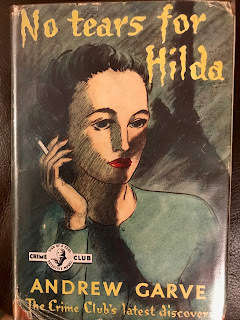
No Tears for Hilda was Andrew Garve's first book to be published by Collins Crime Club. This was in 1950, and Garve was a new pen-name for Paul Winterton, a journalist who had previously published crime novels under the name Roger Bax (he'd later write a few books under another name, Paul Somers). Garve novels would appear regularly until 1978, when Winterton was 70. After that, he retired from the scene, although he lived until just short of his 93rd birthday.
Garve was evidently an interesting individual, a member of the Detection Club and a founder member of the CWA. He stood for election to Parliament in 1931 as a Labour candidate, but since that was the year that Labour were wiped out in a landslide, his political career never got going. It's not easy to find out much about his personal life, though I understand that he wrote a (regrettably unpublished) autobiography. Signed Garve books are hard to come by, and when I came across his personal copy of this title on eBay, I was keen to snaffle it. Now I've read it, I'm glad I did.
This is one of those novels in which a man is charged with murder, but someone close to him insists that he is innocent, and tried to prove it. A familiar scenario, but Garve handles it with a touch of originality, focusing on the psychological make-up of the victim. Although Francis Iles had focused on a 'murderee' almost twenty years earlier, in his extraordinary novel Before the Fact, Garve's approach is very different. The setting and storyline are in keeping with the rather grey mood of the post-war austerity era.
George Lambert's wife Hilda is found dead. At first sight it looks as though she has gassed herself, but it's soon evident that someone killed her. George appears to be the only suspect. He has no alibi, while an affair with a young nurse gives him a motive. His war-time pal Max Easterbrook can't believe that good old George could have committed such a crime. But there are no other suspects.
To find the truth, Max needs to learn more about Hilda's personality. It soon becomes evident that nobody did shed any tears after her death and Garve's attempt to present a rounded psychological portrait of an unpleasant woman is interesting if not, to my mind, wholly successful. But Max's search for the real culprit is interesting and Garve's smooth and accessible prose style kept me turning the pages.
December 8, 2021
The Hardboiled Apple and Raymond Chandler's L.A.

A couple of months ago I about Caroline Crampton's attractive map of Agatha Christie's England. It's another nice idea - along with James Fleming's book, which I mentioned the other day - for a Christmas gift. And now here are a couple more ideas for those crime fans in your life. Two more maps, this time of American locations, but again produced by Herb Lester Associates. Above is a picture of one of them, The Raymond Chandler Map of Los Angeles.
The Hardboiled Apple is, of course, a map of New York, and it's created by Jon Hammer and Karen McBurnie. No fewer than 55 criminal locations are featured, and there is also a 'Timeline of Treachery' taking us from 1845 to 2018. The authors highlighted range from S.S. Van Dine and Ellery Queen to Donald Westlake and Caleb Carr. I was pleased to see mentions for faves of mine such as Cornell Woolrich and Kenneth Fearing and intrigued by some unfamiliar names, like Stefanie Pintoff.
The Chandler-related map is less complex, but includes various points of interest, from the Sternwood Mansion (of course!) to The Cypress Club. Some of Chandler's own residences in L.A. are also featured. As you might imagine, quite a number of the highlights are in or around Hollywood Boulevard. It would look good framed, I think.
December 6, 2021
The Power of the Dog - 2021 film review
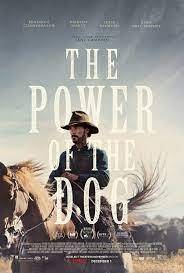
A few years ago Liz Gilbey recommended me to read Thomas Savage's novel The Power of the Dog, which was first published in 1967. I'd never heard of the book or the author and I was surprised when Liz told me that it was a superb crime novel - even more surprised when I bought a copy and started reading. But I soon realised that it's a terrific novel and that Liz's praise was well merited.
Now, more than fifty years after its first appearance, the book has been filmed, by Jane Campion no less. The lead character is the malevolent Montana rancher Phil Burbank and I must admit that if I'd been casting this part, I certainly wouldn't have thought of offering it to Benedict Cumberbatch. But I'd have been wrong. What a brilliant actor he is. Phil is a trick character to portray, but he does a great job.
On the surface, this is a Western, and I would not describe myself as a fan of Westerns (other than Butch Cassidy and the Sundance Kid). It's also a long film, a real slow-burner. The events of the book also move at a measured pace. I do feel that I enjoyed the film more because I'd read and loved the source novel. I felt Campion did Savage justice. It's an impressive piece of work.
I don't want to say too much about the storyline, but Phil and his amiable brother George (Jesse Plemons) are wealthy men who are very different but have a close relationship. That relationship is, in Phil's eyes, threatened when George marries Rose Gordon (Kirsten Dunst), a widow with a teenage son who is intelligent but not exactly macho. Kodi Smit-McPhee does a great job in the role of young Peter. It's a compelling story which is watchable and indeed gripping throughout - even if, like me, you usually prefer your stories to have a bit more pace.
December 4, 2021
Bond Behind the Iron Curtain: Guest post by James Fleming
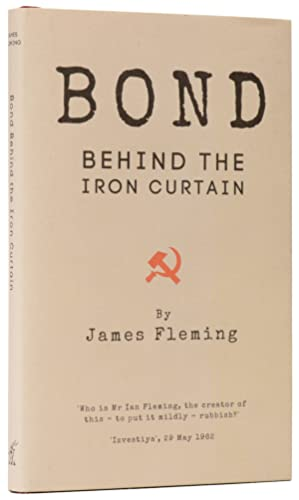
In recent months, I've enjoyed a very pleasant correspondence with James Fleming, nephew of Ian and himself an author of note as well as editor of The Book Collector magazine, which Ian Fleming founded seventy years ago and is still going strong, I'm glad to say.
James' latest book is a nicely illustrated little volume which would make a lovely Christmas gift for the Bond fan in your life. It's called Bond Behind the Iron Curtain. I invited James to talk about it:
'The story is frankly sensational. Amid all their denunciations of capitalism and the west, the Politburo decides to launch an attack on Ian Fleming – in 1962, even before Broccoli and co. had finished filming Dr No. ‘Who is Mr Ian Fleming, the creator of this – to put it mildly – rubbish?’ asked Yuri Okov in Izvestiya? He answered it himself: ‘A retired spy who has turned mediocre writer.’ Why did they do it? As a cover for their nuclear adventure in Cuba? To deflect the anger of the Russian proletariat from their abysmal living conditions? (One May Day banner read: CUT KHRUSCHEV UP FOR SAUSAGES.) “We will probably never know.
Even after the Cuban crisis had been resolved, the Russians kept up their onslaught on Bond. They became obsessed by what they saw as Fleming’s attacks on socialism and Bond’s success with women (which they termed ‘pornography’). Eventually the KGB (no less!) arranged that a Bulgarian novelist, Andrei Gulyashky, who had a hero handy, should write a book in which the hero kills Bond. Gulyashky did as he was told and was then given hard currency, a minder and a visa for Britain and packed off to sell his book internationally. In London he came up against Ann Fleming – Ian’s widow – a tough lady if ever there was one, and her copyright lawyers. When it turned out that no one could legally use 007 except Fleming’s estate, Gulyashky, hilariously, called his man 07.
The KGB may have got nowhere near killing Bond, but through the Gulyashky idea, they certainly rattled the Fleming estate, which was beginning to make big money from the films and books. In order to keep their hands on the golden goose, they now got Kingsley Amis to write the first of what is, to date, thirty-eight spoof Bond books.
In Czechoslovakia, Bulgaria, Poland, and probably other communist countries as well, the underground market in Bond flourished, despite the authorities trying to stamp it out – indeed, to kill him. It’s a fabulous story, completely unknown until now.'
James Fleming, Bond Behind the Iron Curtain, 128pp, hardback, 16 illustrations, from the Book Collector (thebookcollector.co.uk)
December 3, 2021
Forgotten Book - The Murder of the Circus Queen

Anthony Abbot published About the Murder of a Circus Queen in 1932 and the UK edition, which dropped 'About' from the title, came along three years later. It's another Thatcher Colt mystery set in New York City, and his 'Watson', Abbot himself, doesn't hold back: 'Not only was it Colt's most baffling case; it was the most glamorous and sinister'. It's certainly vivid and atmospheric, and the story was promptly filmed. I haven't seen the movie, but if Wikipedia is to be believed, the screenplay made many changes from the original, not least the identity of the culprit and the motive.
The circus has come to town, or to Madison Square Garden to be precise, and it's there, in front of seventeen thousand spectators, that an ingenious murder is committed. Colt and Abbot are present, having been warned by the circus owner and manager, Colonel Tod Robinson, that someone is determined to destroy the business.
Abbot captures the breezy mood of circus life, but I was startled by his presentation of one of the circus acts - members of the Ubangi tribe from Equatorial Africa, complete with their own witch doctor. On doing a bit of research, I discovered that there were real life circuses in the US in the 1930s which featured such acts. Today, this seems shocking and exploitative, but on the fascinating GA Detection site, Mike Grost argues that so far as the novel is concerned, Abbot's treatment of the African characters was, by the standards of the time, progressive.
Judged as an American Golden Age whodunit mystery, this is quite a capable piece work. Abbot shifts suspicion around his suspects and comes up with a satisfactory 'least likely culprit'. There are some touches of ingenuity, especially in the method of killing the circus queen. Colt is very much in the tradition of the Great Detective, while the extraordinary stupidity of the District Attorney makes even Inspector Japp look like Hercule Poirot. Very much a period piece.



